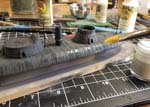Home | Model Making | Writing | Photography | Biography | Contact | Links | Blog
 |
Originally proposed in 1861, USS Keokuk was finally approved on 18 March, 1862, in the post-Hampton Roads rush to build anything and everything that looked like USS Monitor. Unlike Monitor's rotating turret, Keokuk sported two fixed "gun citadels", which remained in place as the gun crews manually moved the guns to one of three gunports in each citadel. She was a one-off design, and one that didn't fare very well under concentrated gunfire. Launched in December of 1862, she went into combat for the first time during the Union Navy's initial attack on Charleston in April, 1863. Sailed to within 550 yards of Fort Moultrie, she took over ninety-plus direct hits, which holed her composite armor --alternating steel and wood beam covered in boiler plate -- and while not a single member of her crew died, she did sink the following day. The Confederates later stole her two 11-inch Dahlgren guns from under the noses of the blockading Union fleet. For more on that story, check out my New York Times piece, "Raiding the Keokuk". |
This is the now out of production Verlinden resin kit, in 1/200 scale. As can be seen in the photos, it's a simple kit, |
| After initial assembly, that took all of 10 minutes, it became apparent that the bolts and armor seams were WAY over scale, as is often the case with ironclad kits. Keokuk's bolts (not rivets, they didn't rivet ironclads) were flush on her decks, so I sanded them off. I thought of using a beading tool to indicate the heads, but I wanted to keep this a more simple and quick build. I also sanded off the molded-on anchor chain and anchors at this point; they were fine, but their removal made sanding the rest of the hull easier, and separate chain and anchors just look better. |
The paint was the thing on this project. I used mostly Vallejo Model Color paints, thinned for airbrushing. After a |
Final details were straight forward. The CMK boats build up very nicely. The Flagship Models railings likewise are |
When in production, this kit could be found for around $25 US, but since Verlinden's demise, I see it on eBay for over $75. I'm not sure if it's worth that much, but it is a simple and fun kit to build, that is also fairly accurate. A note on that accuracy: a lot of models depict Keokuk as having wooden decks. I have never been able to find any proof of that from period documentation, which is why I find this kit in this scale, and Cottage Industry Models 1/96th scale kit of Keokuk, to be the most accurate available. |
 |
 |
 |
 |
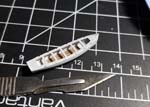 |
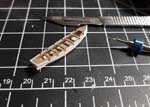 |
 |
 |
 |
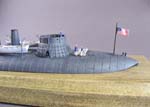 |
 |
 |
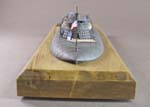 |
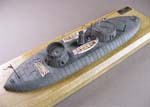 |
